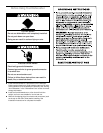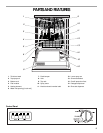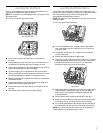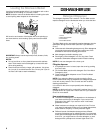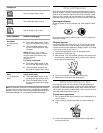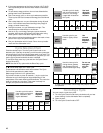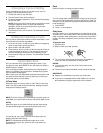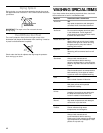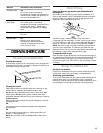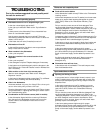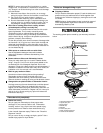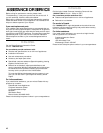
10
4. If the water temperature at the faucet is below 120°F (49°C),
have a qualified person raise the water heater’s thermostat
setting.
■ To save water, energy and time, do not rinse dishes before
putting them into the dishwasher.
■ Use a low energy, quick, or short cycle whenever possible.
These cycles use less hot water and energy than the Normal
cycle.
■ Use a delay feature to run your dishwasher during off-peak
hours. Local utilities recommend avoiding heavy usage of
energy at certain times of day.
■ During the summer, run your dishwasher at night. This
reduces daytime heat buildup in the kitchen.
■ Use an air dry, or an energy-saving dry option whenever
possible. Allow longer drying times (overnight) when using
these options. Use a rinse aid to improve drying.
■ Use cycles or options that add extra heat to the wash or rinse
portion of the cycle only when needed.
■ Run your dishwasher with full loads. Run a rinse cycle after
meals until the dishwasher is full.
Cycle Selection Chart
Press the desired cycle. Turn the Cycle Control knob to the
desired cycle. If the door is latched, you will hear the cycles start
and stop as the Cycle Control knob passes each cycle mark. This
is normal and does not hurt the dishwasher. If you prefer, you can
set the Cycle Control knob with the door unlatched.
To use Rinse Only, press any cycle and turn the Cycle Control
knob to Rinse Only.
NOTE: Use the Air Dry option with the Rinse Only cycle.
A “●” shows what steps are in each cycle.
Temperatures indicate where extra heat is added. The Cycle
Control knob pauses as the water heats.
Water usage is shown in U.S. gallons/liters.
Cycle time includes dry time. An asterisk ( * ) by the cycle time
indicates the cycle time might be longer depending on the
temperature of the water entering the dishwasher. The cooler the
water, the longer the cycle time. If the water is already hot
enough, the cycle time will be as shown.
†
A small amount of water runs through the pump to remove
soil particles.
Canceling a Cycle
You can cancel a cycle at any time.
1. Turn the Cycle Control knob slowly clockwise until you hear
water draining. Let the dishwasher drain completely.
2. Open the door.
3. Turn the Cycle Control knob to OFF.
Wash Rinse Main
Wash
Purge
†
Final
Rinse
Dry Time
(min)
Water
Usage
(gal/L)
●
●●
●
140°F
(60°C)
●
●●
●●
●●
●
140°F
(60°C)
●
●●
●●
●●
●
140°F
(60°C)
●
●●
●
88* 9.1/34.4
Use this cycle for hard-to-
clean, heavily-soiled pots,
pans, casseroles, and
regular tableware.
Use both
detergent
dispenser
sections.
POTS &
PANS
Wash Rinse Main
Wash
Purge
†
Final
Rinse
Dry Time
(min)
Water
Usage
(gal/L)
●
●●
●●
●●
●●
●●
●●
●●
●
140°F
(60°C)
●
●●
●
72* 6.9/26.1
Wash Rinse Main
Wash
Purge
†
Final
Rinse
Dry Time
(min)
Water
Usage
(gal/L)
●
●●
●●
●●
●●
●●
●
140°F
(60°C)
●
●●
●
62* 4.8/18.2
Wash Rinse Main
Wash
Purge
†
Final
Rinse
Dry Time
(min)
Water
Usage
(gal/L)
●
●●
●
140°F
(60°C)
6 2.2/8.3
Use this cycle for loads
with normal amounts of
food soil. (The energy-
usage label is based on
this cycle.)
Use both
detergent
dispenser
sections.
Use this cycle for pre-
rinsed or lightly-soiled
loads.
Use
covered
detergent
dispenser
section.
Use this rinse cycle for
rinsing dishes, glasses,
and silverware that will
not be washed right away.
Do not use
detergent
with this
cycle.
RINSE
& HOLD





